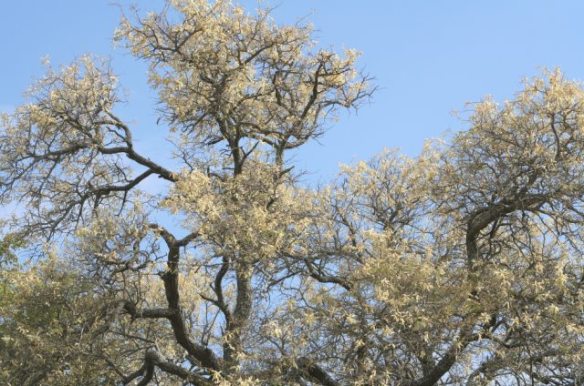And that means that summer is almost upon us. My parents came to spend the weekend with us and the temperatures were in the low 30’s, which is still bearable. Over the three days they were here, we watched bare trees turn green or at least start to in some cases. Within the next week I will have lovely green trees laying shade over the pool. Below you can see the beginnings of greeness – wait…whats that behind the tree?
A large percentage of the trees in our area are acacias. The knob thorn being one of them. At this time of the year they stand out from the surrounding bush with their light yellow flowers.
Acacias – Thorn trees of Africa
There are few more striking symbols of Africa than a thorn tree – its gnarled branches, graceful form, jagged thorns and abundant blooms, in many ways reflecting the paradoxes of the continent.
Acacias are the dominant woody plants over much of sub-Saharan Africa. There are about 700 species in Africa, South America, India and Australia. All belong to the Family Mimosaceae.
African savannahs experience hot and often dry conditions, so plants must find ways of retaining moisture. The way in which acacias have evolved to do this, is to have their leaves divided into dozens of tiny leaflets which can be held horizontally to capture sunlight or vertically to reduce transpiration. Acacia foliage is sought after by many browsing animals – from giraffe to beetles – and here too it helps for them to be divided, as the tiny leaflets left behind by the browsers can continue to perform their vital photosynthesis function.
Many acacias have exaggerated umbrella-shaped crowns which enable the tree to capture the maximum amount of sunlight, with the smallest possible leaves. Some species have deep tap-root systems, allowing them to survive in semi-arid terrain along dry watercourses (they tap into the water table) while others have shallow but extensive splayed root systems to capture limited rainfall in dryer areas. The well-known Fever Tree which grows along lake fringes and on poorly drained clay soils also has a shallow root system, in order to avoid water logging.
Acacias belong to the group of pod-bearing plants known as legumes and have the remarkable ability to enhance soil fertility. The activity of microbes associated with roots of acacias fixes nitrogen to soil particles and so improves fertility.
Just about all parts of an acacia tree are edible to one kind of animal or another, and in many parts of Africa their small leaves provide the only greenery in the dry season, so are bound to be eaten. The roots may be sought after by porcupines, the tiny leaflets by macro- and micro-herbivores, the sticky sap by bush babies, the flower nectar by bees and butterflies, the seeds by beetles, and the stringy bark by elephant.

Acacia leaves and thorns
With so many creatures making a living from their growth efforts, it is no wonder that acacias have evolved some of the most effective and cunning defences in the plant kingdom. Acacia thorns may be straight or hooked depending upon the species and these are capable of keeping all but the largest browsers at bay. Giraffe, however, have leathery tongues which feel no apparent pain against either hooked or straight thorns. To combat large mammalian browsers some acacia trees – such as the Knob Thorn – release chemicals in the form of toxic tannins which render the leaflets unpalatable and cause giraffe or kudu to move on to another tree. To reduce the impact of browsing insects, some acacia species have developed an association with biting ants – ant-plant mutualism – which is one of the most intriguing relationships in the natural world.
The wood of many acacia trees is renowned for its excellent fuel properties and can also produce good charcoal. Since many African people still rely on wood as fuel for cooking and heating it is essential that acacia woodlands are managed effectively in order that the trees do not disappear altogether.
Acacia sap or gum is another important product and the Sweet Thorn and Scented Thorn produce copious amounts which can be used as a glue. “Gum Arabic” was originally derived from the Three-hook Thorn.
Related Articles
- Ants protect trees from elephants (bbc.co.uk)




Interesting article…thank you again, for your wonderful postings.
As to the girrafe (I just spelled that wrong, didn’t I?), took me forever to find it, but then once I did, it’s easy to spot…like one of those Gestalt images. 😉
LikeLike
Yeah – their camouflage is amazing.
LikeLike
great post, thanks for sharing
LikeLike